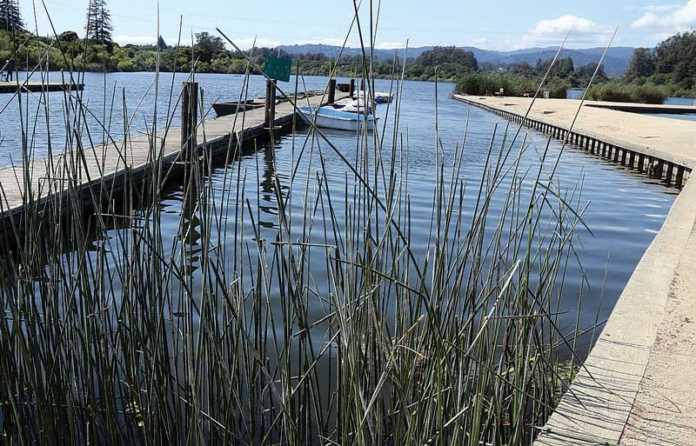(While algae blooms have been increasing worldwide, city officials have been successful at cleaning the water at Pinto Lake. Photo by Tarmo Hannula/Pajaronian)
WATSONVILLE — Three years after starting a program to clean the waters of Pinto Lake, Watsonville city officials are reporting success.
Watsonville Senior Utilities Engineer Jackie McCloud is currently finishing a report that will go public in June, which describes how the program has worked to reduce toxic algal bloom in the lake.
Meanwhile, a report released Tuesday by Washington, D.C.-based Environmental Working Group (EWG) shows that such blooms are becoming commonplace worldwide. While some natural causes cause the blooms, the group said this increase is “indisputably linked to pollution from farms.”
This is because agricultural fertilizer and manure that finds its way into rivers and lakes feeds the harmful bacteria and allows it to flourish.
Efforts to clean Pinto Lake began in 2015, when scientists noticed high concentrations of microcystin, a toxin caused by cyanobacteria, which is commonly called blue-green algae.
Cyanobacteria flourish in the lake thanks to the phosphates running off from agriculture and residential uses, and from erosion of riverbanks.
Microcystin is harmful to people and animals, and has been linked to several otter deaths in the Pajaro River watershed.
Algal blooms can cause fish die-offs and harm other marine life, and can harm local economies by curbing tourism and recreational activities like swimming, fishing and boating, according to EWG.
The two-phase project began two years ago when the city’s environmental scientists turned to the tributaries feeding the lake, which carry sediment from upstream that feed the bacteria and allow it to thrive.
Adding control measures such as rolling dips and detention basins have reduced 100 percent of the sediment entering the lake by those means, McCloud said.
The second phase began last year when city officials added aluminum hydroxide to the water. That chemical binds onto the phosphates that feed the algae to the water, thus reducing the harmful bacteria.
“We significantly reduced phosphorus in the lake by 91 percent,” McCloud said.
While the lake is seeing a bloom typical of warming spring weather, none of it is producing the troubling toxins, she said.
This has allowed the city to keep the lake open for the entirety of this year, compared to last year when toxic blooms forced it to be closed for several weeks.
“To me, having the residents out there for longer periods of time is a measure of success,” she said.
Still, the work is not complete. McCloud said that the city will conduct weekly tests of the water, and next year will do an in-depth sampling at four sites throughout the lake.
In addition, city officials are reaching out to the community with ways they can help reduce the sediment that enters the lake.
This includes reducing the use of fertilizer and detergents, and making sure septic tanks are in good working order.
Techniques such as planting strips of grass next to streams and applying fertilizer using precision methods can also cut water pollution from farms.
“Voluntary programs alone aren’t getting the job done,” said Craig Cox, EWG’s senior vice president for agriculture and natural resources. “It is far past time to expect landowners to meet basic standards of caring for their land and our water.”
The city is also partnering with Watsonville Wetlands Watch to build a “bio-filter,” a stand of plants designed to naturally filter incoming water.
In its report, EWG analyzed news coverage and satellite imagery and found that 300 blooms have been recorded in lakes, rivers and bays in 48 states since 2017, compared to only three blooms in 2010.
According to EWG, toxic algal blooms have erupted in every state. The problem is worst in California, where state agencies issued 141 public health alerts in 2017.
In 2014, Toledo, Ohio became the first large U.S. city where toxic blooms made tap water unsafe for human consumption, the EWG report said.
The problem has also been noted in Australia, Brazil, China and the Gulf of Mexico.
•••
The City of Watsonville will host a Pinto Lake outreach day on Saturday from 10 a.m. until 2 p.m. There, visitors can visit seven stations with activities that include birding and learning about sea otters. They can also visit a fishing station.
Pinto Lake City Park is located at 451 Green Valley Road in Watsonville.
For information, and to see the report, visit www.ewg.org/toxicalgalblooms.













